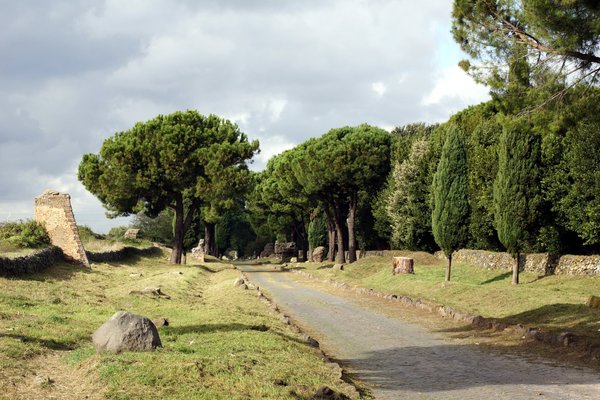Italy
Via Appia
The Via Appia is the first and most important of the great roads built by the Ancient Romans, also known as "regina viarum" (or "queen of roads").
It was built in 312 BC to ensure swift and direct communication between Rome and Capua, an ancient town to the north of Naples. A revolution in road construction, the road was paved with close-fitting slabs of dressed basalt, ensuring it remained passable in all weather conditions, plus it was a public, toll-free road.
Community Perspective: Hubert describes a visit to the Via Appia Antica by bike from Rome, while Matejicek visited the end of the road at Brindisi, and Clyde hiked to the sights close to Rome.
Site Info
Official Information
- Full Name
- Via Appia. Regina Viarum (ID: 1708)
- Country
- Italy
- Status
-
Inscribed 2024
Site history
History of Via Appia
- 2024: Inscribed
- Inscribed
- 2006: Revision
- Includes former TWHS Terracina (1984)
- Type
- Cultural
- Criteria
- iii
- iv
- vi
Links
- UNESCO
- whc.unesco.org
All Links
UNESCO.org
- whc.unesco.org — whc.unesco.org/
Community Information
- Community Category
- Archaeological site: Ancient Rome
Travel Information
Exact locations inscribed twice (or more)
"The Via Appia in Rome, from the 1st to the 13th mile" partly overlaps …
Apulia hotspot
For the Components: "The Appia Traiana at Canusium and the Ofanto course", "The Via …
Rome hotspot
Campania hotspot
Recent Connections
-
Apulia hotspot
For the Components: "The Appia Traiana …
-
WHS inspiring "Classical Music"
The Pines of Rome by Ottorino Respighi …
-
Asterix
Asterix and the Chariot Race
Connections of Via Appia
- Individual People
-
-
Emperor Trajan
"the road (...) was completed in 109 CE by the Emperor Trajan who added the Via Traiana to the last stretch of the Via Appia, connecting Beneventum (Benevento) to Brindisi more easily along the Adriatic Coast." (AB Ev)
-
- Geography
-
-
Tyrhennian Sea
Part of the Via Appia borders the Tyrhennian coast. "(...) the road was built from 312 BCE onwards on the initiative of the Censor Appius Claudius Caecus, to connect Rome to Capua along the Tyrrhenian coast." (AB Ev) -
Linear inscriptions
"a series of linear component parts attesting to the course and structure of the Via Appia" (AB ev) -
Adriatic Sea
Part of the Via Appia, the Via Appia Traiana, runs along the Adriatic coast through Egnatia. The Via Appia ends at Brindisi. "Emperor Trajan (...) added the Via Traiana to the last stretch of the Via Appia, connecting Beneventum (Benevento) to Brindisi more easily along the Adriatic Coast." (AB Ev) -
Located in a Capital City
The first kms are in Rome, the capital of Italy
-
- Trivia
-
-
WHS inspiring "Classical Music"
The Pines of Rome by Ottorino Respighi (1924. One of the 4 movements is titled "I pini della via Appia (link)
-
Depicted in Mizielinska Maps
Via Appia in MinturnaeSee i.pinimg.com
-
- History
-
-
Places of Execution
"In 71 BC, 6,000 slaves were crucified along the 200-kilometer (120 mi) Via Appia from Rome to Capua." (wiki)See en.wikipedia.org
-
- Architecture
-
-
Made out of basaltic material
Road surface was made of basalt stones carefully cut and fitted togetherSee www.livius.org
-
Pre-Romanesque
Santa Maria Genitrici
-
- World Heritage Process
-
-
Perfect Inscriptions
2024 -
Part of Cultural nomination rejected
- "ICOMOS expressed its concerns regarding the compromised conditions of authenticity of component parts 015, 016 and 020 because of the loss of substance of their attributes. (...) In its response in February 2024, the State Party took ICOMOS' concerns on board by only keeping the course of the road for component parts 016 and 020 within the boundaries of the nominated property, thereby placing the archaeological perimeters of the ancient cities in the buffer zone". + "ICOMOS does not consider the inclusion of [the Lanuvium branch road (component part 003), Norba branch road (component part 004) and San Stefano and Torre Santa Sabina branch road (component part 022)] within the boundaries of the nominated property to be sufficiently justified and recommends that they be excluded. (...) The State Party has also removed the San Stefano and Torre Santa Sabina branch roads of component part 022, but wished to maintain the Lanuvium and Norba branch roads". (AB Ev) -
Exact locations inscribed twice (or more)
"The Via Appia in Rome, from the 1st to the 13th mile" partly overlaps with the Rome WHS (inc. Baths of Caracalla). It also shares the Santa Sofia complex in Benevento with the Longobards in Italy.
-
- Religion and Belief
-
-
Pilgrimage route
During the Middle Ages it was used by pilgrims who came to Rome to visit the grave of Saint Peter. -
Mithraism
The property includes "[r]eligious buildings and places of worship" such as "mithraea". (AB Ev)
-
- Human Activity
-
-
Irrigation and drainage
The property includes "[e]ngineering works" like "water canals/water conduits/hydraulic structures". (AB Ev) -
Grand Tour
"It became a key stage of the Grand Tour." (AB ev)
-
- Constructions
-
-
Aqueduct
"The Via Appia is also accompanied by a monumental ensemble of temples, funerary monuments, aqueducts and villas, and at city entrances, triumphal arches, gates or such amenities as theatres, amphitheatres or baths which all bear witness to an ancient civilisation." (AB ev) -
Catacombs
The property includes burial sites such as catacombs. (AB Ev) -
Cisterns
Cisternoni di Albalonga -
Mausolea
Several, including Mausoleum of Cicero -
Necropolises
The property includes burial sites such as necropolises. (AB Ev) -
Notable Bridges
Ponte antico sul Fiume Ofanto -
Monumental Columns
"Two ancient Roman pillars, symbols of Brindisi. They were once thought to mark the ending points of the Appian Way, instead they were used as a port reference for the antique mariners. Only one of the two, standing at 18.74 metres (61.5 ft), is still visible."See en.wikipedia.org
-
Roman amphitheatres
Amphitheatre of Capua -
Baths
"The Via Appia is also accompanied by a monumental ensemble of temples, funerary monuments, aqueducts and villas, and at city entrances, triumphal arches, gates or such amenities as theatres, amphitheatres or baths which all bear witness to an ancient civilisation." (AB ev) -
Triumphal Arches
"The Via Appia is also accompanied by a monumental ensemble of temples, funerary monuments, aqueducts and villas, and at city entrances, triumphal arches, gates or such amenities as theatres, amphitheatres or baths which all bear witness to an ancient civilisation." (AB ev)
-
- Timeline
-
-
Built in the 4th century BC
"built under the authority of the Censor Appius Claudius Caecus from 312 BCE onwards" (AB ev)
-
- WHS Hotspots
-
-
Apulia hotspot
For the Components: "The Appia Traiana at Canusium and the Ofanto course", "The Via Appia on the "tarantino" sheep-track", "The Via Appia from Mesochorum to Scamnum", "Tarentum", "The Appia Traiana along the Adriatic coast, through Egnatia", "Brundisium" / About 1h10 from Bari to Brindisi by train; about 1h20 by train from Bari to Taranto.
-
Rome hotspot
Starts in the outskirts of Rome -
Campania hotspot
For the Components: "The Via Appia from Sinuessa to the Pagus Sarclanus", "Ancient Capua", "Beneventum and the Arch of Trajan" an "The Via Appia on the route from Beneventum to Aeclanum"
-
- WHS Names
-
-
Named after individual people
"The road is named after Appius Claudius Caecus, the Roman censor who, during the Samnite Wars, began and completed the first section as a military road to the south in 312 BC" (wiki) -
Untranslated Toponyms
"Via" is Latin for "road". It's repeated in the subtitle Regina Viarum (Queen of roads).
-
- Literature & Film
-
-
Asterix
Asterix and the Chariot Race
-
News
No news.
Recent Visitors
Visitors of Via Appia
- Adam Hancock
- Alberto Rodriguez Gutierrez
- Alexander Lehmann
- Aljaz
- Ammon Watkins
- Ana Lozano
- Argo
- Astraftis
- Atila Ege
- awestix
- Bernard Joseph Esposo Guerrero
- BeyondMonkey
- Bin
- bossc
- Bram de Bruin
- Bropyk
- Carlos Sotelo
- Cheryl
- Christoph
- Christravelblog
- Clyde
- Damientournay
- Dani Cyr
- Daniel Chazad
- Daniel Gabi
- Danny L
- Dan Pettigrew
- David Berlanda
- Dimitar Krastev
- Dolemite92
- Doubanjiang
- Dwight Zehuan Xiao
- Elia Vettorato
- eljx1988
- Els Slots
- Errol Neo
- Eva Kisgyorgy
- Farinelli
- Feldhase
- Femke Roos
- Flexiear
- forest80
- Frédéric M
- Frederik Dawson
- George Gdanski
- GeorgeIng61
- GerhardM
- giulio25
- Gjert
- Hadrianus
- H Beswick
- Hubert
- Hughes1920
- Hurrvinek
- Ian Cade
- IreneKD
- ivantham
- Jaakkotoivanen
- Jakob F.
- janem
- Janos
- Jan-Willem
- Jarek Pokrzywnicki
- Jason Boulette
- Javier Coro
- Jawnbeary
- Jean Lecaillon
- Jeffrey Chai
- Jgriffindor6
- JL
- J_neveryes
- João Aender
- John Smaranda
- Jonas Hagung
- Jonas Kremer
- Jon Eshuijs
- Jon Opol
- Jonoprout
- Jurre
- Karito Vies
- Kasper
- Kerékgyártó
- Kevin McFarland
- Klara Woodson
- KngAlaric
- Kristin
- Krzysztof B
- kutasp
- Lara Adler
- lindaann
- Linneaaasaurus
- Lisu Marian
- Luboang
- Lucio
- Ludvan
- Luis Filipe Gaspar
- Lukasz Palczewski
- lynnz317@aol.com
- Maciej Gil
- Mahuhe
- MarcoB_0
- Martina Rúčková
- Matejicek
- Mathijs
- Matthewsharris
- MaxHeAnouBen
- MH
- Mia esguerra
- Mihai Dascalu
- Mikko
- Monica Tasciotti
- MoPython
- nan
- Nasebaer
- Nick M
- Nihal Ege
- Paola Laura
- Patrik
- Paul Schofield
- PeterH
- Petteri
- Philipp Leu
- Philipp Peterer
- Pincze
- Piotr Wasil
- Porcho
- Purrfect
- Rafał Kałczuga
- Ralf Regele
- Reisedachs
- Reza
- Riccardo Quaranta
- Rick Ohm
- rivr
- Roccobot
- Roger Ourset
- Roman Bruehwiler
- Rudegirl
- Samy G
- Sandra!
- scubarrie
- Sebasfhb
- Sergio Arjona
- shoaibmnagi
- Simonf
- SirLoydd
- Solivagant
- Sorel Americo
- Stanimir
- Stanislaw Warwas
- StaziG
- Stijn
- Szabolcs Mosonyi
- Szucs Tamas
- TaiTT
- Tamara Ratz
- Taotao Chen
- Tarquinio_Superbo
- Thomas Buechler
- Thomas van der Walt
- Tim Allen
- tommasorossotti
- tony0001
- triath
- Tsunami
- Twobaconsandaboston
- Viaje al Patrimonio
- Vincent Cheung
- VLabhard
- voyager
- WILLIAM RICH
- Wojciech Fedoruk
- Xander Huang
- Xiquinho Silva
- Yevhen Ivanovych
- ynteligent
- Zoë Sheng
Community Reviews
Show full reviews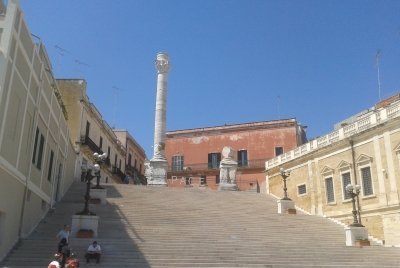
Though I visited Rome several times, it was still not enough to visit all the interesting places in Rome, not to mention the places around. In May 2023, I traveled to Salento region in the Southern Italy, so I took opportunity and did a stop in Brindisi. This place was the end of extended Via Appia, and the reason why Brindisi was connected to Rome was a possibility to travel to Greece and the East by sailing from the local port.
Brindisi is now important port and tourist spot. One can find however several interesting monuments spanning two millennia in the relatively small and rather unassuming historical core. The only site related to Via Appia that could be seen is its "official" end marked by giant two columns (PHOTO). Well, only one is remaining because the second one was moved to nearby Lecce and used as a base for the statue of Saint Oronzo.
As clearly evident, there is not much to see from Via Appia in Brindisi, and it is necessary to visit other components to get OUV of this tentative site.
Besides the columns in Brindisi, I could see small remaining of Roman pavement, the part of side branches of Via Appia, in Bari on Piazza del Ferrarese. Hopefully, the strategy of the state party of Italy will not follow the way paved by Danube Limes WHS, where every single stone is included as the separate component.
Keep reading 0 comments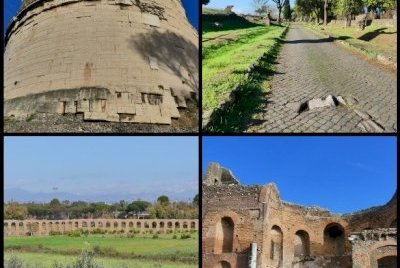
I visited this tWHS in 2022. Most probably I had already passed by Porta San Sebastiano and the rather ugly and urban part of the Via Appia several times in the past, but I had no photos and no real idea what possible OUV this site has to offer. So this time round, I allowed a full day to hike as much as possible and check it out. Be advised that the way, although almost flat, can get muddy so sturdy hiking shoes will certainly help.
The Appian Way in Rome is an ancient road built in 312 b.C. by Appius Claudius Caecus. The city’s gateway to the East connected Rome with Capua. It stretched from the Roman Forum for 400 miles to Brindisi, where ships sailed to Egypt and Greece, and it served as a military and economic artery. The Appian Way was revolutionary for that period and was the first Roman road to feature lime cement. The natural starting point when staying in Rome proper is going to be Porta Latina or Porta San Sebastiano. The walls near the latter are far more stunning than the first part of the old Via Appia, so much so that there is an interesting Museo delle Mura inside. The constant traffic at the rather narrow two-way road, the lack of pavements sometimes, and the amount of bicycles and/or scooters might put you off at first as the only worthy monuments left to see are a replica of the Colonna del …
Keep reading 0 comments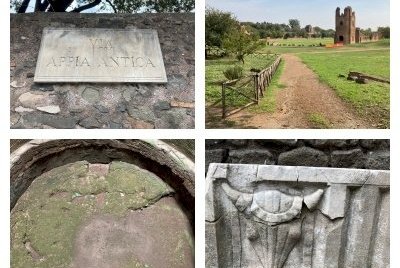
My trip mates were surprised to hear that Rome only has one WHS (two if you count the Vatican as well). So many great monuments that could be WHS on their own! However, if all goes to Italy’s plan, the city will have another one in 2024: the Via Appia. This “revolution in road construction” will be a serial nomination of 22 stretches between Rome and Brindisi. It will be interesting to see whether there is a core zone overlap with the Rome WHS, as the Via Appia traditionally started at the Forum Romanum. The road with the name ‘Via Appia Antica’ now starts from the edge of the city at Porta San Sebastiano, a gate passing through the Aurelian Walls.
During my 2022 trip to Rome, I visited just a short section of the Via Appia. It’s not easy to do so on foot, as the road is narrow without room for a pavement and there is constant vehicle traffic. The sights also are spread out miles apart. You’ll encounter many cyclists (often in guided groups and not well-trained in cycling), who seem to have chosen the best way to explore this linear site.
Fortunately, bus #118 travels part of the ancient road, and we took it from the Baths of Caracalla. After 4km, we disembarked near a field that turned out to be the Circus of Maxentius. It has the remains of a chariot racetrack and a mausoleum. This area in Antiquity was a well-to-do suburb. …
Keep reading 0 comments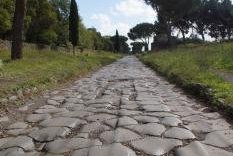
The Via Appia was the first and one of the most important road systems built by the ancient Romans. I'm not sure whether Italy will ever submit this tentative site for inscription, if so, certainly the entire road network will be included. During our trip to Rome in November 2013, we visited the Via Appia Antica, a 16 km long section of the ancient road starting at the Porta San Sebastiano. Actually we wanted to visit only the Catacombs of Callixtus, but the weather was warm and sunny, so we decided to rent bicycles and to explore a stretch of the ancient road. There is a tourist information (Via Appia Antica 58), where we rented the bikes and picked up a map showing the monuments along the road, the bus 118 (from metro Circo Massimo) stops in front of the tourist information.
The first section of the Via Appia is a busy street, the scenic part begins at the church of San Sebastiano. From there, the car traffic is restricted to residents. We enjoyed our bicycle ride, you have to drive slowly, because there are bumpy cobblestones throughout or you have to use the green strip along the road. We rented mountain bikes, a good decision. There is still the ancient paving in some sections, you can see the deep grooves from the wheels of the heavy waggons (photo).
In ancient Rome, it was forbidden to bury the dead in the city, so the tombs were built along the main …
Keep reading 0 comments
